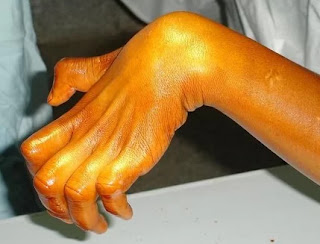Introduction:
Claw hand deformity, also known as "ape hand" or "main en griffe," is a condition characterized by the abnormal positioning of the fingers and hand. This deformity can significantly impact an individual's ability to perform everyday tasks, affecting their quality of life. In this article, we will explore the causes of claw hand deformity, its symptoms, and potential treatment options.
Causes of Claw Hand Deformity:
Ulnar Nerve Palsy:
One of the primary causes of claw hand deformity is damage or compression of the ulnar nerve. The ulnar nerve runs from the neck down to the hand, controlling the muscles responsible for fine motor movements in the fingers. Injury or compression of the ulnar nerve disrupts the normal functioning of these muscles, leading to the characteristic claw-like positioning of the fingers.
Motor Neuron Diseases:
Conditions affecting motor neurons, such as Amyotrophic Lateral Sclerosis (ALS) or Charcot-Marie-Tooth disease, can result in claw hand deformity. Motor neurons are responsible for transmitting signals from the brain to the muscles, and any dysfunction in this pathway can lead to muscle weakness and deformities.
Peripheral Neuropathy:
Peripheral neuropathy refers to damage or dysfunction of the peripheral nerves, which can be caused by conditions like diabetes, alcohol abuse, or certain infections. When the nerves that control finger movements are affected, it can result in the development of claw hand deformity.
Rheumatoid Arthritis:
Chronic inflammatory conditions like rheumatoid arthritis can impact the joints and tendons in the hand. As the disease progresses, it may lead to deformities, including claw hands, due to joint destruction and tendon abnormalities.
Dupuytren's Contracture:
Dupuytren's contracture is a condition characterized by the thickening and tightening of the connective tissue in the palm. As the condition progresses, it can cause the fingers to bend towards the palm, contributing to the development of claw hand deformity.
Symptoms:
The main symptoms of claw hand deformity include:
- Abnormal flexion of the fingers, particularly the fourth and fifth fingers.
- Inability to fully extend the affected fingers.
- Difficulty with fine motor skills, such as grasping small objects or buttoning clothes.
Treatment Options:
Conservative Management:
In some cases, conservative measures such as physical therapy and splinting may be employed to maintain hand function and prevent further deformity.
Medications:
Medications, such as anti-inflammatory drugs or those targeting underlying conditions like rheumatoid arthritis, may be prescribed to manage symptoms and slow down disease progression.
Surgical Intervention:
In severe cases, especially when caused by nerve compression or joint deformities, surgical interventions may be considered. These procedures aim to release compressed nerves, repair damaged tendons, or correct joint abnormalities.
Conclusion
Claw hand deformity is a complex condition with various underlying causes. Early diagnosis and appropriate management are crucial to preventing further progression and improving the quality of life for individuals affected by this deformity.
Consultation with a healthcare professional, such as a neurologist or orthopedic surgeon, is essential for an accurate diagnosis and the development of an appropriate treatment plan tailored to the specific cause of the deformity.




Physiotherapy Clinic in perinthalmanna
ReplyDelete